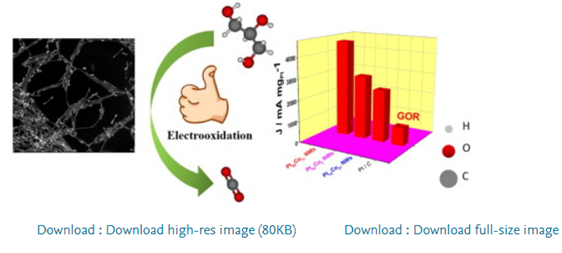Ultrathin one-dimensional platinum-cobalt nanowires as efficient catalysts for the glycerol oxidation reaction
Qiwen Sun a , Fei Gao a , Yangping Zhang a , Caiqin Wang b, * (王彩琴), Xing Zhu c , Yukou Du a, *(杜玉扣)
a College of Chemistry, Chemical Engineering and Materials Science, Soochow University, Suzhou 215123, PR China
b College of Science, Nanjing Forestry University, 159 Longpan Road, Nanjing 210037, PR China c Testing and Analysis Center, Soochow University, 199 Renai Road, Suzhou 215123, PR China
Journal of Colloid and Interface Science 556 (2019) 441--448
Direct fuel cells are regarded as the most portable device for alleviating the problems of the energy dilemma and environmental disruption. Although direct fuel cells have a number of advantages, the lack of highly-efficient anode catalysts inhibits their wide application. To address this challenge, we report a facile one-pot method to fabricate a series of ultrathin platinum-cobalt (Pt-Co) nanowires with different proportions. The as-prepared catalysts all have one-dimensional ultrathin nanowire structures with high yields. Among all these catalysts, the ultrathin Pt89Co11 nanowires with optimized compositions, whose diameters are 1.8 nm on average, show the best catalytic activity for the glycerol oxidation reaction in alkaline conditions, and their mass and specific activities reach 4573.0 mA mg−1 and 11.9 mA cm−2, which are 5.4 and 3.6 times higher than those of commercial Pt/C catalysts, respectively. The as-obtained Pt89Co11 nanowires are also the most durable nanowires according to long-term stability tests. This method may provide guidelines for the preparation of other Pt-based bimetallic nanowires, which could somewhat accelerate the development and commercialization of catalysts for fuel cells.

链接:https://www.sciencedirect.com/science/article/pii/S0021979719309944?via%3Dihub